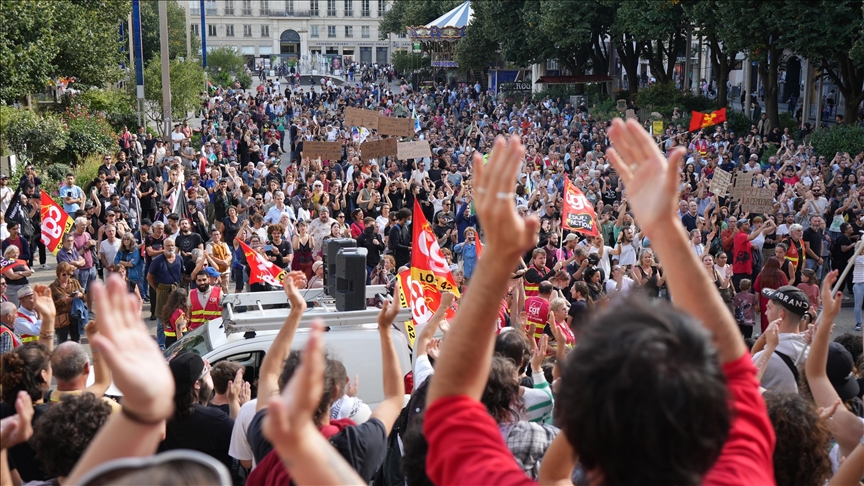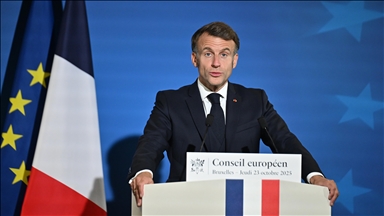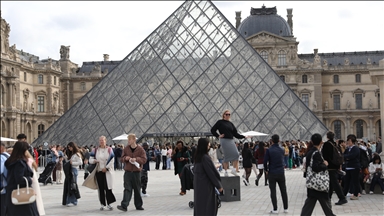EXPLAINER – Republic on strike: Why protests never stop in France
More than 50 years after upheaval of 1968, strikes remain France’s loudest bargaining chip

- Relations between governments and workers keep cycle alive as from pension reform to labor liberalization, successive administrations have tried to push through contested policies
ISTANBUL
France is set for another day of nationwide strikes on Thursday as trade unions intensify pressure on newly appointed Prime Minister Sebastien Lecornu to abandon austerity measures.
Teachers, transport workers, hospital staff, and public sector employees are expected to walk out in what unions promise will be a bigger show of force than the Sept. 10 demonstrations, which attracted hundreds of thousands of people across the country.
But why do strikes remain such a recurring phenomenon in France?
The story begins in the 19th century, when industrial workers first organized to demand dignity in the workplace.
In 1864, France gave people the legal right to strike with the passage of the Ollivier Law under Napoleon III, ending decades of prohibition dating back to the Napoleonic Penal Code.
Before that, workers who attempted to organize or stop work faced harsh penalties, including fines, imprisonment, or even forced labor.
This was a turning point that gave workers a formal instrument to press their demands.
Yet strikes were allowed only if there was no violence, intimidation, or obstruction.
In the decades that followed, mass mobilizations became a central feature of French social life.
In 1906, the Courrieres mine disaster, one of Europe’s deadliest industrial accidents, which killed more than 1,000 miners, triggered a wave of anger and solidarity.
Strikes quickly spread through the coalfields of northern France and into the railway sector as workers demanded safer conditions, better wages, and recognition of their rights.
A year later, in 1907, a different front of protest emerged in the South. Faced with collapsing wine prices and economic hardship, tens of thousands of winegrowers in the Languedoc region organized mass demonstrations.
The marches swelled into one of the largest rural protests in the country’s history.
Clashes with security forces left at least six people dead.
The biggest win from this right came in 1936, when over a million French workers went on strike following the election victory of the Popular Front party led by Prime Minister Leon Blum.
They secured historic gains, a 40-hour work week, and paid holidays.
Nothing, however, shaped modern France more than the May 1968 general strike under President Charles de Gaulle, when 10 million workers and students brought the country to a halt, paralyzing factories, universities, and transport networks.
For the first time in modern French history, students and workers joined forces, demanding not only higher wages and labor rights but also greater personal freedoms, gender equality and an end to outdated hierarchies.
Paris was the epicenter, where it all began with student demonstrations at the University of Nanterre and the Sorbonne before spreading to the Latin Quarter.
Lyon, France’s second-largest city, witnessed violent clashes between students, workers, and police. In Nantes, workers occupied factories and even declared a form of “self-management.”
The protests left at least seven people dead, thousands injure,d and more than 7,000 arrested.
The country teetered on the edge of political collapse, forcing de Gaulle to briefly flee to a military base in Germany before regrouping.
French labor protections are among the toughest in the world, giving workers confidence to walk out without fear of losing their jobs.
The rhythm continued through the 1970s with factory occupations like that of watchmakers at LIP, a French watchmaking company based in Besancon.
The factory announced mass layoffs and bankruptcy that year, sparking outrage among its 1,200 workers.
In response, employees occupied the factory, took control of production, and began selling watches themselves to pay their wages.
The momentum carried into the 1980s.
Despite coming to power on a Socialist platform in 1981, President Francois Mitterrand’s government soon adopted austerity measures to stabilize the economy.
The shift sparked an immediate backlash. In 1983, rail workers launched one of the largest strikes of the decade, halting train traffic nationwide for days.
Teachers staged repeated walkouts over cuts to education budgets and wage restraints, while health workers and civil servants joined in solidarity.
While clashes with police left several injured and dozens detained, no deaths were reported.
Pensions at heart of unrest
If one theme has defined French strikes over the past three decades, it is pensions.
In 1995, Prime Minister Alain Juppe’s plan to overhaul the pension system triggered one of the largest strikes since 1968.
For three weeks, rail networks stood still, Paris Metro stations were locked shut, and daily life slowed to a crawl. Millions marched nationwide in freezing temperatures.
The scale of the mobilization shocked the government, forcing Juppe to abandon the reform.
In the Autumn of 2010, millions marched against President Nicolas Sarkozy’s pension reform, which gradually raised the retirement age from 60 to 62.
Oil refinery blockades caused nationwide fuel shortages, with long queues stretching at petrol stations. Students joined workers in protest, marching alongside unions in a display of intergenerational solidarity.
Despite weeks of strikes, marches and fuel disruptions, the government stood firm.
Parliament passed the reform in November 2010, and it was signed into law shortly after.
From unions to grassroots movements
Over time, France’s protest culture expanded beyond organized labor with bottom-up movements.
The 2018-2020 “Yellow Vest” movement marked another turning point, erupting spontaneously from rural towns and suburban roundabouts in response to a planned fuel tax hike.
Unlike traditional strikes, the movement had no clear leadership or formal structure. Yet week after week, thousands donned their fluorescent vests and marched in cities across France.
The protests spread rapidly, organized on social media rather than through union halls, and at their peak drew up to 280,000 demonstrators nationwide on a single day.
The unrest was among the most violent France had seen in decades.
Between November 2018 and June 2019, at least 11 people were killed in protest-related incidents, more than 4,000 were injured, and over 10,000were arrested during clashes with police.
Major urban centers, including Paris, Marseille, Lyon, Toulouse, Bordeaux, Lille, and Nantes, witnessed repeated confrontations marked by tear gas, water cannons, and street barricades.
In 2023, President Emmanuel Macron’s decision to push the retirement age further to 64 brought the country to a standstill.
Paris and other major cities were engulfed in waves of marches and clashes, with up to 3.5 million people on the streets at the peak, according to unions (about 1.2 million according to police).
Piles of uncollected garbage lined the boulevards as sanitation workers walked off the job, while transport stoppages froze much of the country.
The protest saw over 1,500 arrests nationwide, including 457 on a single day of mobilization on March 23.
In 2024, France witnessed a string of major protests.
Farmers launched nationwide blockades in January against subsidy cuts and fuel tax plans, mobilizing tens of thousands of demonstrators with tractor convoys that disrupted highways and fuel supplies.
The movement left two people dead, at least 91 arrested, and three others injured.
More than 50 years after the upheaval of 1968, the strike remains France’s loudest bargaining chip.
Political unrest flared again in June, when the rise of the far-right National Rally (RN) ahead of snap elections triggered demonstrations in Paris, Marseille, Lyon, Nantes, and other cities, resulting in more than 33 arrests and at least 10 injuries.
Most recently, on Sept. 10, 2025, a grassroots online call to “Block Everything” against former Prime Minister Francois Bayrou’s budget plan mobilized thousands nationwide.
What began as a small digital campaign spilled onto the streets. Demonstrators erected barricades, blocked roads and transport hubs, and staged marches across major cities.
Trade unions soon joined the wave of resistance by calling for their own day of mobilization, staging marches and strikes that drew nearly 800,000 people across France.
Just a day earlier, Bayrou had lost a confidence vote in the National Assembly, becoming the fourth prime minister to fall in less than two years.
In an attempt to restore stability, Macron appointed Armed Forces Minister Sebastien Lecornu as prime minister on the same day.
Even though union membership has shrunk since the 1970s, its power to mobilize is undiminished. Groups such as the CGT, UNSA, F,O and CFDT still command the ability to flood the streets with hundreds of thousands and sometimes millions of demonstrators.
Anadolu Agency website contains only a portion of the news stories offered to subscribers in the AA News Broadcasting System (HAS), and in summarized form. Please contact us for subscription options.







